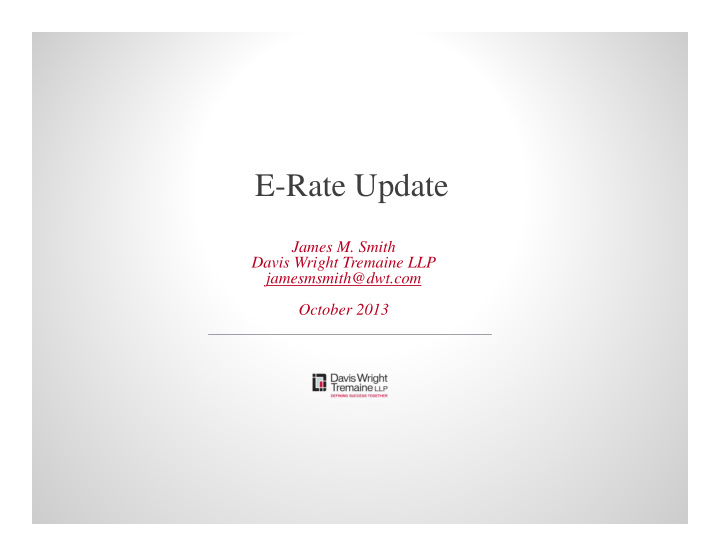



E-Rate Update James M. Smith Davis Wright Tremaine LLP jamesmsmith@dwt.com October 2013
I. E-Rate Basics One of four USF programs under Section 254 of the Telecommunications Act of 1996: subsidizes telecom and Internet services to schools and libraries nationwide $2.25 billion funding cap ($2.38B after inflation index) ESL: Priority 1 (services) and 2 (internal connections) In current FY, $4.9B in requests; no P2 funding Currently serves 97% of US schools – But: little change in program or funding cap since 1997 – 77-80% of S&Ls have inadequate broadband service to support digital learning; half at <3Mbps 2
II. This Year’s E-Rate Reform Initiatives The Goal: Transforming E-rate into a high speed broadband fund to support digital learning June 6: President Obama’s “ConnectEd” Initiative – Connect 99% of students at 100 Mbps by 2015, plus Wi-Fi within schools; target 1 Gbps by 2020 (“We are living in a digital age, and to help our students get ahead, we must make sure they have access to cutting-edge technology”) – Vehicle: FCC must “modernize and leverage its existing E-Rate program.” Embraced by (Democratic) majority of FCC– so . . . July 19: E-Rate Reform NPRM (WC Dkt. 13-184) – 175 pages, hundreds of questions but very few firm proposals. – 750+ Comments filed in September, Reply Comments in November – Final Order (and FNPRM?) projected bsometime in 2014 3
III. Highlights of the E-Rate NPRM Goal: “To ensure that our nation’s students and communities have access to high-capacity broadband connections that support digital learning while making sure that the program remains fiscally responsible.” (1) affordable access to 21st Century broadband (2) maximize cost-effectiveness of E-rate funds (3) Streamline administration of the E-rate program [but many NPRM proposals would add complexity] 4
III. Highlights of the E-Rate NPRM (cont’d) Major Proposals/Ideas: – Increase funded BB speeds per ConnectEd – Pay for it– how? “Efficiencies,” “cost savings,” “streamlining,” eliminate support for “obsolete services;” “temporary” increase in cap? [Barely mentioned: contribution reform] – Phase out subsidies for arguably outdated services [paging, DA, stand-alone voice service, email, web hosting mentioned] – Alter discount matrix/ increase S&L funding match? [flat 25-30%]– Commr. Pai – Simplify ESL/eliminate P1-P2 distinctions, service categories 5
III. Highlights of the E-Rate NPRM (cont’d) Major Proposals/Ideas (cont’d): – Technology-neutral? Or preference for fiber? • Fund dark fiber with modulating electronics to light it? – District-wide funding? – Preference for consortia? – Per-Mbps pricing benchmarks/maximums? – Overall cap? Per-student or per-building cap? [Pai] – Greater rural support? – One-time application for multi-year contracts? – Competitive bidding reforms? MSAs? – “Increase transparency” (post pricing info and bid docs, officer certifications, lengthen document retention, audits, LCP reforms, etc., etc. 6
IV. The Politics Between the lines: FCC majority (D) wants to increase funding to implement ConnectEd; Minority (R) is skeptical of “another big-government program.” Senate Democrats support: Senate Commerce Committee Chairman Jay Rockefeller (D-WV), Sen. Ed Markey (D-MA) (architects of original E-rate law) Education Secy. Duncan: “slight increase in [USF] fees for the short term” might be necessary Wash. Post: $4-6 billion expanded program funded by increasing USF fees to cellphone users by $12 over 3 years. WH deputy: ConnectEd has “a lot of the characteristics of big-vision policy that you really don’t get through legislation anymore;” “We are here to do big things — and we can do this without Congress.” Republicans disagree, may fight : “Most consumers would balk at higher costs, higher phone bills, and I sure hope that this is not part of the equation that ultimately comes out” (House E&C Committee Chairman Fred Upton (R-MI). Education Community: Just Do It. 7
V. The Story So Far (Themes of FCC Comments) Billion$ in potential new funding: feeding frenzy? – S&L community supports doubling or tripling of cap ($5-6 billion); strongly opposes higher funding matches. Telecom Provider Positions – NCTA: If E-rate cap raised, fund by imposing overall USF cap. – NTCA: Don’t cannibalize other USF programs. – AT&T: Eliminate POTs support. – ITTA: Keep POTS support for now, allow market to dictate pace of IP transition. More Broadband Infrastructure v. Anti-Overbuilding Lit Fiber v. Dark Fiber Wireless (including offsite) v. Wireline (oppose WiFi hotspots) Webhosting, paging, email, etc. 8
V. The Story So Far: Major Issues in Comments National Capacity Goals v. Flexibility: many say local conditions/school needs should dictate – “Turbo-Tax” template to allow schools to assess bandwidth needs – NTCA/WTA: “Availability – Affordability” “Transparency”: Opposition to proposals that would increase burdens, add complexity – 10-year doc retention, officer certifications, bid docs/pricing disclosures, audits ( a la Lifeline ETCs), price benchmarks, more USAC reviews Streamlining: Most favor multiyear contracts, direct disbursements to applicants (BEAR), faster USAC funding decisions 9
VI. The Elephants in the Room Election Year 2014/Budgetary/Debt Ceiling Politics – ConnectEd as signature Obama agenda item – Republican/Conservative Opposition to higher-cost program, “big government,” anti-Obama Robbing Peter to Pay Paul (aka raiding HCF/Lifeline) Caps? (program, per-student/building): Commr. Pai Contribution Reform! – Broadband Internet Access Service as Telecom – Pre-Wheeler FCC has refused to tackle. Will the Wheeler FCC? 10
Recommend
More recommend